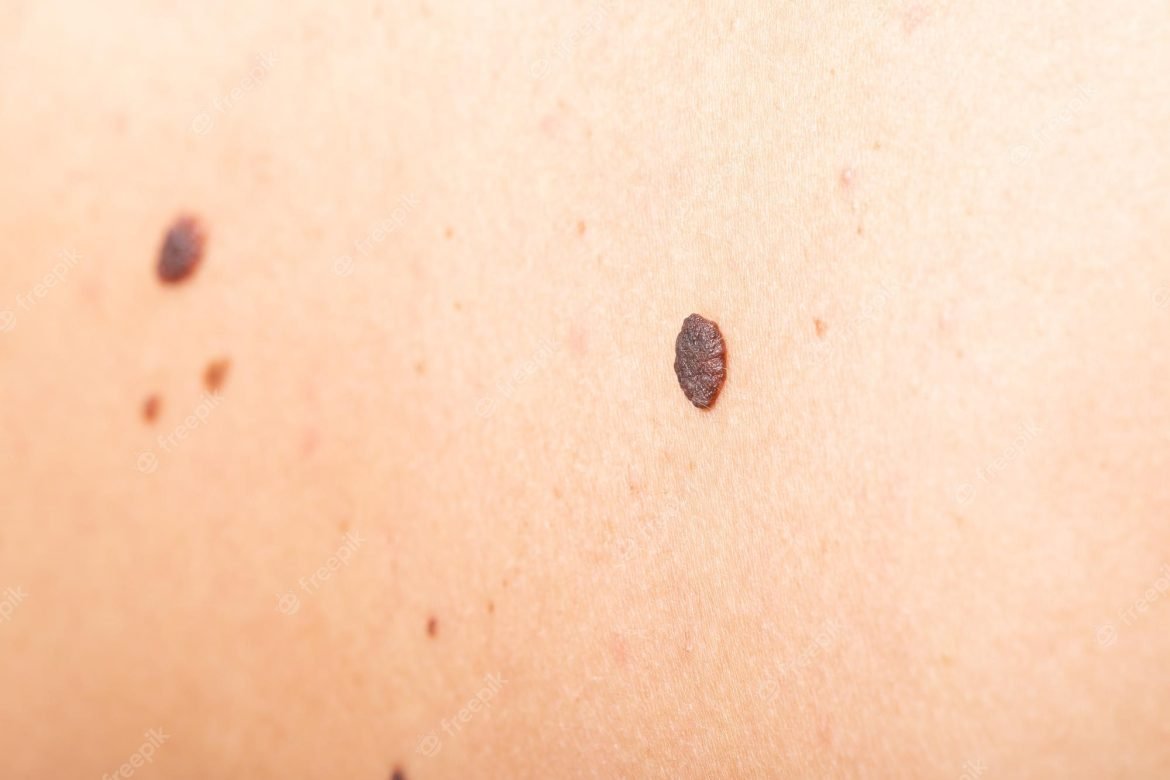
Introduction
When it comes to our skin, various marks and blemishes can make their appearance. Two common skin irregularities that often lead to confusion are moles and birthmarks. While they might seem similar at first glance, moles and birthmarks have distinct characteristics, origins, and implications. In this article, we’ll delve into the topic of moles and birthmarks, unraveling their differences and exploring the fascinating world of skin markings.
Understanding Moles
What Are Moles?
Moles, scientifically known as nevi, are small pigmented spots that develop on the skin’s surface. They are typically brown or black and can vary in size and shape. Moles are formed when pigment cells, known as melanocytes, grow in clusters instead of being evenly distributed.
Types of Moles
There are several types of moles, each with its own distinct characteristics. Common moles are usually round and small, while dysplastic moles might have irregular borders and a mixture of colors. Congenital moles are present at birth, and acquired moles develop over time due to sun exposure and other factors.
Causes of Moles
The primary cause of moles is the overproduction of melanin, the pigment responsible for skin, hair, and eye color. Genetics plays a significant role in the development of moles, as well as exposure to ultraviolet (UV) radiation from the sun. Hormonal changes, such as those during pregnancy, can also lead to the appearance of new moles.
Unraveling Birthmarks
Birthmark Definition
Birthmarks are visible skin markings that are present at birth or appear shortly afterward. They can be found in a variety of colors, shapes, and sizes, and their causes are diverse.
Different Types of Birthmarks
There are two main categories of birthmarks: vascular and pigmented. Vascular birthmarks result from abnormal blood vessels, and they include port-wine stains and hemangiomas. Pigmented birthmarks, on the other hand, are caused by an overgrowth of pigment cells and encompass café-au-lait spots and Mongolian spots.
Causes of Birthmarks
The exact causes of birthmarks are still being studied, but genetics and developmental factors are thought to play significant roles. Some birthmarks, particularly vascular ones, might be linked to genetic mutations affecting blood vessel formation. Pigmented birthmarks can occur due to irregularities in melanocyte distribution.
Moles vs. Birthmarks: Differentiating Features
Appearance and Texture
Moles often appear as raised or flat spots on the skin’s surface, while birthmarks can have various textures. Vascular birthmarks might be slightly raised, whereas pigmented birthmarks are usually flat and evenly colored.
Development over Time
Moles can change in size and color over the years, and some might even disappear with age. Birthmarks, on the other hand, tend to remain relatively stable in appearance, although some might fade or shrink over time.
Medical Significance
While most moles are harmless, some can be precursors to skin cancer. It’s essential to monitor moles for changes in size, shape, color, or texture. Birthmarks are generally benign and don’t pose significant health risks, but exceptions exist, particularly for large or vascular birthmarks that might interfere with bodily functions.
The Role of Genetics
Genetic Factors in Moles
Genetics heavily influence the number of moles an individual has and their susceptibility to developing new ones. If a close family member has numerous moles, there’s a higher likelihood of the same pattern occurring in another family member.
Genetic Influences on Birthmarks
Certain types of birthmarks, such as port-wine stains, have been linked to genetic mutations. However, the inheritance patterns of birthmarks are complex and can vary widely depending on the specific type of birthmark.
Family History
A family history of moles or birthmarks can increase an individual’s likelihood of having these markings. Regular screenings and dermatologist visits are essential for those with a family history of skin irregularities to ensure early detection of any potential issues.
When to Seek Medical Attention
Moles and Skin Cancer
While most moles are benign, any changes in size, shape, color, or texture should be evaluated by a dermatologist. Skin cancer, including melanoma, can develop within moles, making early detection crucial for successful treatment.
Birthmarks and Health Concerns
Most birthmarks are harmless and don’t require medical intervention. However, if a birthmark is causing physical discomfort, affecting bodily functions, or impacting self-esteem, medical consultation is advisable.
Monitoring Changes
Regular self-examinations are recommended for both moles and birthmarks. Tracking changes and consulting a medical professional if any irregularities are noted can contribute to overall skin health.
Treatment and Removal Options
Removing Moles
Moles can be removed for cosmetic reasons or if they pose a risk of developing into skin cancer. Removal methods include excision, shaving, and laser removal, each with its own benefits and considerations.
Treating Birthmarks
Treatment for birthmarks depends on the type and location. Vascular birthmarks might be treated with laser therapy, while pigmented birthmarks might fade naturally over time. In some cases, medical intervention is considered for functional or aesthetic reasons.
Medical Procedures
Medical advancements, such as laser technology and minimally invasive procedures, have revolutionized mole and birthmark treatments. Consultation with a dermatologist can help determine the most suitable approach.
Embracing Your Unique Skin
Boosting Self-Confidence
Moles and birthmarks are part of what makes individuals unique. Embracing these features can boost self-confidence and inspire self-love.
Redefining Beauty Standards
The beauty industry is slowly diversifying its representation of skin features, encouraging a shift toward broader acceptance of all skin types.
Embracing Diversity
Moles and birthmarks showcase the diversity of human skin. Celebrating this diversity can help challenge societal norms and promote inclusivity.
Common Misconceptions
Moles as Indicators of Personality
While folklore has linked moles to personality traits, there is no scientific basis for such claims. Moles are primarily determined by genetics and skin pigment distribution.
Birthmarks and Reincarnation
Certain cultures believe birthmarks are tied to past lives, but this is a belief rather than a scientific fact. Birthmarks result from natural developmental processes.
Dispelling Myths
It’s essential to approach moles and birthmarks with scientific understanding, dispelling unfounded myths and embracing the reality of their origins.
Cultural and Historical Significance
Symbolism of Moles
Different cultures have assigned various meanings to moles, often associating them with luck, wealth, or even character traits. These cultural interpretations offer insight into the diverse perceptions of skin features.
Birthmarks in Folklore
Birthmarks have also been subject to cultural interpretations and superstitions. They hold a place in folklore and history, reflecting humanity’s complex relationship with appearance.
Changing Perceptions
Societal attitudes toward moles and birthmarks are evolving. Through education and representation, we can challenge beauty norms and promote a more inclusive view of skin.
Impact on Mental Health
Body Image and Self-Esteem
Moles and birthmarks can impact an individual’s body image and self-esteem. Cultivating self-acceptance and seeking support can mitigate these effects.
Coping with Skin Irregularities
Education and open conversations about skin irregularities can help individuals cope with societal pressures and enhance their mental well-being.
Seeking Support
If feelings of insecurity arise due to moles or birthmarks, seeking support from friends, family, or mental health professionals can provide valuable reassurance.
Taking Care of Your Skin
Sun Protection
Regular use of sunscreen and protective clothing is essential for safeguarding moles and birthmarks from sun damage.
Skincare Routine
Maintaining a healthy skincare routine can help keep your skin in optimal condition, reducing the risk of irritation around moles and birthmarks.
Preventive Measures
Preventing skin trauma and avoiding picking at moles or birthmarks can reduce the likelihood of complications.
Celebrities and Their Marks
Celebrating Uniqueness
Celebrities with moles and birthmarks have embraced their unique features, inspiring others to do the same and fostering self-confidence.
Role Models in Embracing Skin Features
By celebrating their own natural characteristics, celebrities can influence beauty standards and empower individuals to feel proud of their appearance.
Challenging Beauty Norms
Celebrities challenging conventional beauty norms can inspire a broader acceptance of diverse skin features and promote self-love.
Future Research and Developments
Advances in Dermatology
Ongoing research in dermatology is likely to yield innovative treatments and interventions for moles and birthmarks.
Potential Treatments
As technology advances, more efficient and effective treatments for moles and birthmarks could become available.
Holistic Approaches
A holistic approach to skincare, incorporating both medical and psychological considerations, could become more prevalent in the treatment of skin irregularities.
Educational Initiatives
Raising Awareness
Educational campaigns can raise awareness about the differences between moles and birthmarks, dispelling misconceptions and promoting accurate information.
Promoting Self-Examinations
Encouraging regular self-examinations can empower individuals to monitor their skin health and seek medical attention when needed.
Encouraging Early Detection
Educational initiatives can stress the importance of early detection for skin cancer and other potential health concerns related to moles and birthmarks.
Conclusion
In the realm of skin markings, moles and birthmarks have distinct characteristics and origins. While moles are clusters of pigment cells, birthmarks are present at birth or appear shortly after. Understanding these differences empowers individuals to embrace their unique skin features and take proactive steps to ensure skin health. By dispelling myths, challenging beauty norms, and promoting education, we can foster a society that celebrates diversity and self-acceptance.
FAQs
Q1: Can moles develop into skin cancer? A: While most moles are harmless, changes in size, shape, color, or texture could indicate skin cancer. Regular monitoring and dermatologist visits are crucial for early detection.
Q2: Do birthmarks fade over time? A: Some birthmarks, especially vascular ones, might fade over time. However, others remain relatively stable in appearance.
Q3: Can birthmarks be removed? A: Depending on the type and location, some birthmarks can be treated with medical procedures like laser therapy. Removal for cosmetic reasons is also possible.
Q4: Are birthmarks linked to past lives? A: While some cultures believe this, the scientific explanation for birthmarks is rooted in natural developmental processes and genetics.
Q5: How can I boost my self-confidence with moles or birthmarks? A: Embracing your unique features and seeking support from friends, family, or mental health professionals can boost your self-confidence and well-being.



